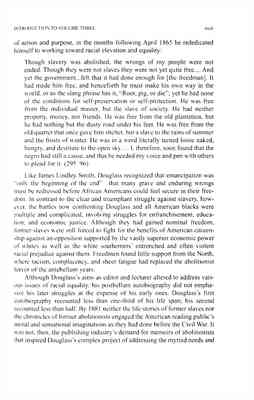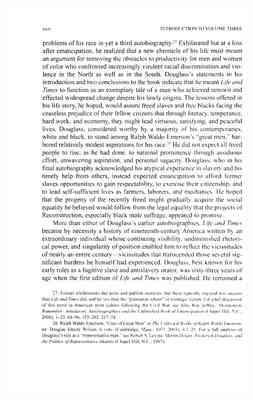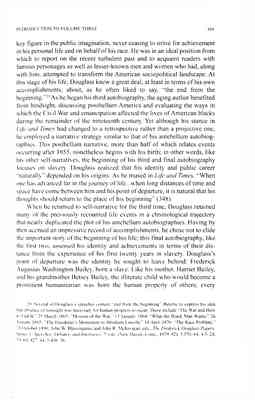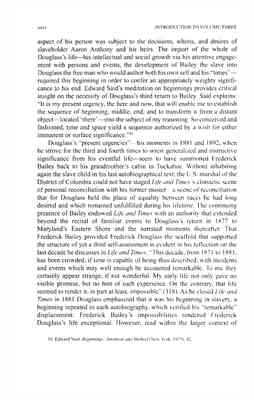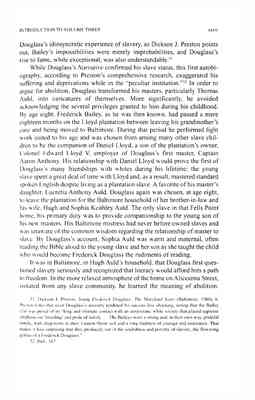Pages
11
INTRODUCTION TO VOLUME THREE xxiii
of action and purpose, in the months following April 1865 he rededicated himself to working toward racial elevation and equality:
Though slavery was abolished, the wrongs of my people were not ended. Though they were not slaves they were not yet quite free.... And yet the government... felt that it had done enough for [the freedman]. It had made him free, and henceforth he must make his own way in the world, or as the slang phrase has it, "Root, pig, or die"; yet he had none of the conditions for self-preservation or self-protection. He was free from the individual master, but the slave of society. He had neither property, money, nor friends. He was free from the old plantation, but he had nothing but the dusty road under his feet. He was free from the old quarter that once gave him shelter, but a slave to the rains of summer and the frosts of winter. He was in a word literally turned loose naked, hungry, and destitute to the open sky.... I, therefore, soon found that the negro had still a cause, and that he needed my voice and pen with others to plead for it. (295–96)
Like James Lindley Smith, Douglass recognized that emancipation was "only the beginning of the end"—that many grave and enduring wrongs must be redressed before African Americans could feel secure in their freedom. In contrast to the clear and triumphant struggle against slavery, however, the battles now confronting Douglass and all American blacks were multiple and complicated, involving struggles for enfranchisement, education, and economic justice. Although they had gained nominal freedom, former slaves were still forced to fight for the benefits of American citizenship against an opposition supported by the vastly superior economic power of whites as well as the white southerners' entrenched and often violent racial prejudice against them. Freedmen found little support from the North, where racism, complacency, and sheer fatigue had replaced the abolitionist fervor of the antebellum years.
Although Douglass's aims as editor and lecturer altered to address various issues of racial equality, his postbellum autobiography did not emphasize his later struggles at the expense of his early ones. Douglass's first autobiography recounted less than one-third of his life span; his second rernunted less than half. By 1881 neither the life stories of former slaves nor the chronicles of former abolitionists engaged the American reading public's moral and sensational imaginations as they had done before the Civil War. It was not, then, the publishing industry's demand for memoirs of abolitionists that inspired Douglass's complex project of addressing the myriad needs and
12
xxiv INTRODUCTION TO VOLUME THREE
problems of his race in yet a third autobiography.27 Exhilarated but at a loss after emancipation, he realized that a new chronicle of his life must mount an argument for removing the obstacles to productivity for men and women of color who confronted increasingly virulent racial discrimination and violence in the North as well as in the South. Douglass's statements in his introduction and two conclusions to the book indicate that he meant Life and Times to function as an exemplary tale of a man who achieved renown and effected widespread change despite his lowly origins. The lessons offered in his life story, he hoped, would assure freed slaves and free blacks facing the ceaseless prejudice of their fellow citizens that through literacy, temperance, hard work, and economy, they might lead virtuous, satisfying, and peaceful lives. Douglass, considered worthy by a majority of his contemporaries, white and black, to stand among Ralph Waldo Emerson's "great men," harbored relatively modest aspirations for his race.28 He did not expect all freed people to rise, as he had done, to national prominence through assiduous effort, unwavering aspiration, and personal sagacity. Douglass, who in his final autobiography acknowledged his atypical experience in slavery and his timely help from others, instead expected emancipation to afford former slaves opportunities to gain respectability, to exercise their citizenship, and to lead self-sufficient lives as farmers, laborers, and mechanics. He hoped that the progeny of the recently freed might gradually acquire the social equality he believed would follow from the legal equality that the projects of Reconstruction, especially black male suffrage, appeared to promise.
More than either of Douglass's earlier autobiographies, Life and Times became by necessity a history of nineteenth-century America written by an extraordinary individual whose continuing visibility, undiminished rhetorical power, and singularity of position enabled him to reflect the vicissitudes of nearly an entire century—vicissitudes that transcended those several significant burdens he himself had experienced. Douglass, best known for his early roles as a fugitive slave and antislavery orator, was sixty-three years of age when the first edition of Life and Times was published. He remained a
2727. Former abolitionists did write and publish memoirs, but these typically enjoyed less success than Life and Times did, and far less than the "plantation school" of nostalgic fiction. For a full discussion of this trend in American print culture following the Civil War, see Julie Roy Jeffrey, Abolitionists Remember: Antislavery Autobiographies and the Unfinished Work of Emancipation (Chapel Hill, N.C., 2008), 1–25, 61–96, 155–202, 217–54.
2828. Ralph Waldo Emerson. "Uses of Great Men" in The Collected Works of Ralph Waldo Emerson ed. Douglas Emory Wilson. 6 vols. (Cambridge, Mass., 1971 2003). 4:1 20. For a full analysis of Douglass's role as a "representative man," see Robert S. I.evine, Martin Delany, Frederick Douglass, and the Politics of Representative Identity (Chapel Hill. N.C. 1997)
13
INTRODUCTION TO VOLUME THREE xxv
key figure in the public imagination, never ceasing to strive for achievement in his personal life and on behalf of his race. He was in an ideal position from which to report on the recent turbulent past and to acquaint readers with famous personages as well as lesser-known men and women who had, along with him, attempted to transform the American sociopolitical landscape. At this stage of his life, Douglass knew a great deal, at least in terms of his own accomplishments, about, as he often liked to say, "the end from the beginning."29 As he began his third autobiography, the aging author benefited from hindsight, discussing postbellum America and evaluating the ways in which the Civil War and emancipation affected the lives of American blacks during the remainder of the nineteenth century. Yet although his stance in Life and Times had changed to a retrospective rather than a projective one, he employed a narrative strategy similar to that of his antebellum autobiographies. This postbellum narrative, more than half of which relates events occurring after 1855, nonetheless begins with his birth; in other words, like his other self-narratives, the beginning of his third and final autobiography focuses on slavery. Douglass realized that his identity and public career "naturally" depended on his origins. As he mused in Life and Times, "When one has advanced far in the journey of life... when long distances of time and space have come between him and his point of departure, it is natural that his thoughts should return to the place of his beginning" (348).
When he returned to self-narrative for the third time, Douglass retained many of the previously recounted life events in a chronological trajectory that nearly duplicated the plot of his antebellum autobiographies. Having by then accrued an impressive record of accomplishments, he chose not to elide the important story of the beginning of his life; this final autobiography, like the first two, assessed his identity and achievements in terms of their distance from the experience of his first twenty years in slavery. Douglass's point of departure was the identity he sought to leave behind: Frederick Augustus Washington Bailey, born a slave. Like his mother, Harriet Bailey, and his grandmother Betsey Bailey, the illiterate child who would become a prominent humanitarian was born the human property of others; every
2929. Several of Douglass's speeches contain "end from the beginning" rhetoric to express his idea the absence of foresight was necessary for human progress to occur. These include "The War and How to End It," 25 March 1863; "Mission of War," 13 January 1864; "What the Black Man Wants," 26 January 1865; "The Freedman's Monument to Abraham Lincoln," 14 April 1876; "The Race Problem," 21 October 1890; John W. Blassingame and John R. McKivigan, eds., The Frederick Douglass Papers, Series 1: Speeches, Debates, and Interviews, 5 vols (New Haven, Conn., 1979–92). 3:570–84, 4:3–24, 59–69, 427–44, 5:436–56.
14
xxvi INTRODUCTION TO VOLUME THREE
aspect of his person was subject to the decisions, whims, and desires of slaveholder Aaron Anthony and his heirs. The import of the whole of Douglass 's life—his intellectual and social growth via his attentive engagement with persons and events, the development of Bailey the slave into Douglass the free man who would author both his own self and his "times"— required this beginning in order to confer an appropriately weighty significance to his end. Edward Said's meditation on beginnings provides critical insight on the necessity of Douglass's third return to Bailey. Said explains: "It is my present urgency, the here and now, that will enable me to establish the sequence of beginning, middle, end, and to transform it from a distant object—located 'there'—into the subject of my reasoning. So conceived and fashioned, time and space yield a sequence authorized by a wish for either immanent or surface significance."30
Douglass's "present urgencies"—his moments in 1881 and 1892, when he strove for the third and fourth times to wrest generalized and instructive significance from his eventful life—seem to have summoned Frederick Bailey back to his grandmother's cabin in Tuckahoe. Without inhabiting again the slave child in his last autobiographical text, the U.S. marshal of the District of Columbia could not have staged Life and Times's climactic scene of personal reconciliation with his former master—a scene of reconciliation that for Douglass held the place of equality between races he had long desired and which remained unfulfilled during his lifetime. The continuing presence of Bailey endowed Life and Times with an authority that extended beyond the recital of familiar events to Douglass 's return in 1877 to Maryland's Eastern Shore and the narrated moments thereafter. That Frederick Bailey provided Frederick Douglass the scaffold that supported the structure of yet a third self-assessment is evident in his reflection on the last decade he discusses in Life and Times: "This decade, from 1871 to 188I, has been crowded, if time is capable of being thus described. With incidents and events which may well enough be accounted remarkable. To me they certainly appear strange, if not wonderful. My early lite not only gave no visible promise, but no hint of such experience. On the contrary, that life seemed to render it, in part at least, impossible" (318). As he closed Life and Times in 1881 Douglass emphasized that it was his beginning in slavery, a beginning repeated in each autobiography, which verified his "remarkable" displacement; Frederick Bailey's impossibilities rendered Frederick Douglass's life exceptional. However, read within the larger context of
3030. Edward Said, Beginnings: Intention and Method (New York, 1975), 42.
15
INTRODUCTION TO VOLUME THREE xxvii
Douglass's idiosyncratic experience of slavery, as Dickson J. Preston points out, Bailey's impossibilities were merely improbabilities, and Douglass's rise to fame, while exceptional, was also understandable.31
While Douglass's Narrative confirmed his slave status, this first autobiography, according to Preston's comprehensive research, exaggerated his suffering and deprivations while in the "peculiar institution." 32 In order to argue for abolition, Douglass transformed his masters, particularly Thomas Auld, into caricatures of themselves. More significantly, he avoided acknowledging the several privileges granted to him during his childhood. By age eight, Frederick Bailey, as he was then known, had passed a mere eighteen months on the Lloyd plantation between leaving his grandmother's care and being moved to Baltimore. During that period he performed light work suited to his age and was chosen from among many other slave children to be the companion of Daniel Lloyd, a son of the plantation's owner, Colonel Edward Lloyd V, employer of Douglass 's first master, Captain Aaron Anthony. His relationship with Daniel Lloyd would prove the first of Douglass's many friendships with whites during his lifetime; the young slave spent a great deal of time with Lloyd and, as a result, mastered standard spoken English despite living as a plantation slave. A favorite of his master's daughter, Lucretia Anthony Auld, Douglass again was chosen, at age eight, to leave the plantation for the Baltimore household of her brother-in-law and his wife, Hugh and Sophia Keithley Auld. The only slave in that Fells Point home, his primary duty was to provide companionship to the young son of his new masters. His Baltimore mistress had never before owned slaves and was unaware of the common wisdom regarding the relationship of master to slave. By Douglass's account, Sophia Auld was warm and maternal, often reading the Bible aloud to the young slave and her son as she taught the child who would become Frederick Douglass the rudiments of reading.
It was in Baltimore, in Hugh Auld's household, that Douglass first questioned slavery seriously and recognized that literacy would afford him a path to freedom. In the more relaxed atmosphere of the home on Aliceanna Street, isolated from any slave community, he learned the meaning of abolition.
3131. Dickson J. Preston, Young Frederick Douglass: The Maryland Years (Baltimore, 1980), 6. Preston notes that even Douglass's ancestry rendered his success lass shocking, noting that the Bailey clan was proud of its "long and intimate contact with an aristocratic white society that placed supreme emphasis on 'breeding' and pride of family.... the Bailey's were a strong and, in their own way, prideful family, with deep roots in their Eastern Shore soil and a long tradition of courage and endurance. That makes it less surprising that they produced, out of the sordidness and poverty of slavery, the flowering genious of a Frederick Douglass."
3232. Ibid.,167
